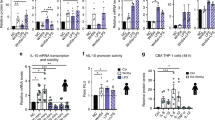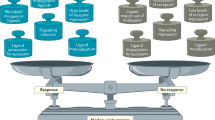Abstract
Zinc is a trace element that is essential for the function of many enzymes and transcription factors. Zinc deficiency results in defects in innate and acquired immune responses. However, little is known about the mechanism(s) by which zinc affects immune cell function. Here we show that stimulation with the Toll-like receptor 4 agonist lipopolysaccharide (LPS) altered the expression of zinc transporters in dendritic cells and thereby decreased intracellular free zinc. A zinc chelator mimicked the effects of LPS, whereas zinc supplementation or overexpression of the gene encoding Zip6, a zinc transporter whose expression was reduced by LPS, inhibited LPS-induced upregulation of major histocompatibility complex class II and costimulatory molecules. These results establish a link between Toll-like receptor signaling and zinc homeostasis.
This is a preview of subscription content, access via your institution
Access options
Subscribe to this journal
Receive 12 print issues and online access
$209.00 per year
only $17.42 per issue
Buy this article
- Purchase on Springer Link
- Instant access to full article PDF
Prices may be subject to local taxes which are calculated during checkout






Similar content being viewed by others
References
Prasad, A.S. Zinc: an overview. Nutrition 11, 93–99 (1995).
Vallee, B.L. & Falchuk, K.H. The biochemical basis of zinc physiology. Physiol. Rev. 73, 79–118 (1993).
Pabo, C.O., Peisach, E. & Grant, R.A. Design and selection of novel Cys2His2 zinc finger proteins. Annu. Rev. Biochem. 70, 313–340 (2001).
Joazeiro, C.A. & Weissman, A.M. RING finger proteins: mediators of ubiquitin ligase activity. Cell 102, 549–552 (2000).
Kadrmas, J.L. & Beckerle, M.C. The LIM domain: from the cytoskeleton to the nucleus. Nat. Rev. Mol. Cell Biol. 5, 920–931 (2004).
Vallee, B.L. The function of metallothionein. Neurochem. Int. 27, 23–33 (1995).
Eide, D.J. The SLC39 family of metal ion transporters. Pflugers Arch. 447, 796–800 (2004).
Palmiter, R.D. & Huang, L. Efflux and compartmentalization of zinc by members of the SLC30 family of solute carriers. Pflugers Arch. 447, 744–751 (2004).
Colvin, R.A., Fontaine, C.P., Laskowski, M. & Thomas, D. Zn2+ transporters and Zn2+ homeostasis in neurons. Eur. J. Pharmacol. 479, 171–185 (2003).
Kambe, T., Yamaguchi-Iwai, Y., Sasaki, R. & Nagao, M. Overview of mammalian zinc transporters. Cell. Mol. Life Sci. 61, 49–68 (2004).
Yamashita, S. et al. Zinc transporter LIVI controls epithelial-mesenchymal transition in zebrafish gastrula organizer. Nature 429, 298–302 (2004).
Siklar, Z., Tuna, C., Dallar, Y. & Tanyer, G. Zinc deficiency: a contributing factor of short stature in growth hormone deficient children. J. Trop. Pediatr. 49, 187–188 (2003).
Ganss, B. & Jheon, A. Zinc finger transcription factors in skeletal development. Crit. Rev. Oral Biol. Med. 15, 282–297 (2004).
Ashworth, A., Morris, S.S., Lira, P.I. & Grantham-McGregor, S.M. Zinc supplementation, mental development and behaviour in low birth weight term infants in northeast Brazil. Eur. J. Clin. Nutr. 52, 223–227 (1998).
Licastro, F. et al. Immune-endocrine status and coeliac disease in children with Down's syndrome: relationships with zinc and cognitive efficiency. Brain Res. Bull. 55, 313–317 (2001).
Prasad, A.S. Zinc and immunity. Mol. Cell. Biochem. 188, 63–69 (1998).
Fraker, P.J. & King, L.E. Reprogramming of the immune system during zinc deficiency. Annu. Rev. Nutr. 24, 277–298 (2004).
Fisher, W.C. & Black, R.E. Zinc and the risk for infectious disease. Annu. Rev. Nutr. 24, 255–275 (2004).
Hosea, H.J., Rector, E.S. & Taylor, C.G. Zinc-deficient rats have fewer recent thymic emigrant (CD90+) T lymphocytes in spleen and blood. J. Nutr. 133, 4239–4242 (2003).
Prasad, A.S. Effects of zinc deficiency on Th1 and Th2 cytokine shifts. J. Infect. Dis. 182, S62–S68 (2000).
Ibs, K.H. & Rink, L. Zinc-altered immune function. J. Nutr. 133, 1452S–1456S (2003).
Banchereau, J. & Steinman, R.M. Dendritic cells and the control of immunity. Nature 392, 245–252 (1998).
Mellman, I. & Steinman, R.M. Dendritic cells: specialized and regulated antigen processing machines. Cell 106, 255–258 (2001).
Steinman, R.M., Hawiger, D. & Nussenzweig, M.C. Tolerogenic dendritic cells. Annu. Rev. Immunol. 21, 685–711 (2003).
Pierre, P. et al. Developmental regulation of MHC class II transport in mouse dendritic cells. Nature 388, 787–792 (1997).
Turley, S.J. et al. Transport of peptide-MHC class II complexes in developing dendritic cells. Science 288, 522–527 (2000).
Chow, A., Toomre, D., Garrett, W. & Mellman, I. Dendritic cell maturation triggers retrograde MHC class II transport from lysosomes to the plasma membrane. Nature 418, 988–994 (2002).
Trombetta, E.S. & Mellman, I. Cell biology of antigen processing in vitro and in vivo. Annu. Rev. Immunol. 23, 975–1028 (2005).
Villadangos, J.A. et al. MHC class II expression is regulated in dendritic cells independently of invariant chain degradation. Immunity 14, 739–749 (2001).
Tamura, T. et al. The role of antigenic peptide in CD4+ T helper phenotype development in a T cell receptor transgenic model. Int. Immunol. 16, 1691–1699 (2004).
Prasad, A.S. Zinc: an overview. Nutrition 11, 93–99 (1995).
Palmiter, R.D. & Huang, L. Efflux and compartmentalization of zinc by members of the SLC30 family of solute carriers. Pflugers Arch. 447, 744–751 (2004).
Liuzzi, J.P. & Cousins, R.J. Mammalian zinc transporters. Annu. Rev. Nutr. 24, 151–172 (2004).
Takeda, K. & Akira, S. TLR signaling pathways. Semin. Immunol. 16, 3–9 (2004).
Palmiter, R.D. Protection against zinc toxicity by metallothionein and zinc transporter 1. Proc. Natl. Acad. Sci. USA 101, 4918–4923 (2004).
Aballay, A., Stahl, P.D. & Mayorga, L.S. Phorbol ester promotes endocytosis by activating a factor involved in endosome fusion. J. Cell Sci. 112, 2549–2557 (1999).
Garrett, W.S.C.L., Kroschewski, R., Ebersold, M., Turley, S., Trombetta, S., Galan, J.E. & Mellman, I. Developmental control of endocytosis in dendritic cells by Cdc42. Cell 102, 325–334 (2000).
Aballay, A., Stahl, P.D. & Mayorga, L.S. Phorbol ester promotes endocytosis by activating a factor involved in endosome fusion. J. Cell Sci. 112, 2549–2557 (1999).
Kaisho, T., Takeuchi, O., Kawai, T., Hoshino, K. & Akira, S. Endotoxin-induced maturation of MyD88-deficient dendritic cells. J. Immunol. 166, 5688–5694 (2001).
Yamamoto, M. et al. Role of adaptor TRIF in the MyD88-independent toll-like receptor signaling pathway. Science 301, 640–643 (2003).
Park, S.J. et al. IL-6 regulates in vivo dendritic cell differentiation through STAT3 activation. J. Immunol. 173, 3844–3854 (2004).
Kitamura, H. et al. IL-6-STAT3 controls intracellular MHC class II αβ dimer level through cathepsin S activity in dendritic cells. Immunity 23, 491–502 (2005).
Acknowledgements
We thank K. Takatsu (University of Tokyo, Tokyo, Japan) for P25 TCR–transgenic mice; T. Saito (RIKEN RCAI, Yokohama, Japan) for Phoenix cells; T. Sudo (Toray, Kamakura, Japan) for CHO cells producing granulocyte-macrophage colony-stimulating factor; T. Mitchell (University of Louisville, Louisville, Kentucky) for the pMSCV-IRES-Thy1.1 retroviral vector; O. Ohara (DNA Kazusa, Kazusa and RIKEN RCAI, Yokohama, Japan) for mouse Zip6 cDNA; A. Ito, T. Yamasaki, E. Iketani and T. Hayashi for technical assistance; and R. Masuda and M. Shimura for secretarial assistance. Supported by a Grant-in-Aid for Scientific Research from the Ministry of Education, Culture, Sports, Science and Technology in Japan (S.Y., M.M. and T.H.), the Uehara Foundation (M.M.) and the Osaka Foundation for the Promotion of Clinical Immunology (M.M. and T.H.).
Author information
Authors and Affiliations
Contributions
H.K. and H.M. did most of the experiments; H.K. helped with retrovirus infection and did experiments using T cells; M.I. helped with the quantitative PCR; S.H. helped with the flow cytometry; T.F. and S.Y. provided advice for the experiments and manuscript; T.K. and S.A. provided knockout mice and some reagents and advice for the experiments and manuscript; and M.M. and T.H. designed all the experiments and prepared the manuscript.
Corresponding author
Ethics declarations
Competing interests
The authors declare no competing financial interests.
Supplementary information
Supplementary Fig. 1
TPEN increased surface expression of MHCII and MHCI but not that of CD40 and CD80 molecules in DCs. (PDF 69 kb)
Supplementary Fig. 2
TPEN treatment, which decreased intracellular zinc did not alter expression of H2-Ab1 or Cd86 mRNA and did not induce cytokine expression in DCs. (PDF 83 kb)
Supplementary Fig. 3
Effect of TPEN on DC maturation was not due to contaminating endotoxin. (PDF 100 kb)
Supplementary Fig. 4
Zinc ion plus zinc pyrithione but not zinc ion or zinc pyrithione alone inhibited LPS-induced decrease of free zinc in DCs. (PDF 86 kb)
Supplementary Fig. 5
LPS and polyIC but not R-848 and CpG treatment decreased intracellular zinc level in DCs. (PDF 48 kb)
Supplementary Fig. 6
TPEN injection increased surface expression of MHCII molecules on DCs. (PDF 27 kb)
Supplementary Fig. 7
Zinc plus pyrithione treatment inhibited R-848- and CpG-induced upregulation of MHCII and CD86 in DCs. (PDF 30 kb)
Supplementary Fig. 8
Specificity of anti-Zip6 polyclonal antibody. (PDF 245 kb)
Supplementary Table 1
PCR primers. (PDF 17 kb)
Rights and permissions
About this article
Cite this article
Kitamura, H., Morikawa, H., Kamon, H. et al. Toll-like receptor–mediated regulation of zinc homeostasis influences dendritic cell function. Nat Immunol 7, 971–977 (2006). https://doi.org/10.1038/ni1373
Received:
Accepted:
Published:
Issue Date:
DOI: https://doi.org/10.1038/ni1373
This article is cited by
-
Prophylactic administration of ivermectin attenuates SARS-CoV-2 induced disease in a Syrian Hamster Model
The Journal of Antibiotics (2023)
-
An Overexpression of SLC30A6 Gene Contributes to Cardiomyocyte Dysfunction via Affecting Mitochondria and Inducing Activations in K-Acetylation and Epigenetic Proteins
Biochemical Genetics (2023)
-
Inflammatory Responses in Periodontitis with or Without Rheumatoid Arthritis Alter Salivary Metallothionein and Zinc
Biological Trace Element Research (2023)
-
Regulating metalloimmunology with nanomedicine for cancer therapy
Nano Research (2023)
-
Immune-regulating strategy against rheumatoid arthritis by inducing tolerogenic dendritic cells with modified zinc peroxide nanoparticles
Journal of Nanobiotechnology (2022)



